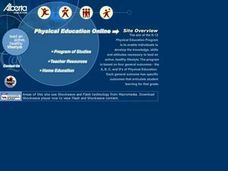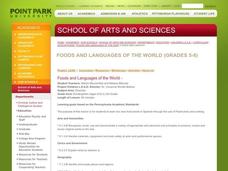Curated OER
Nutrition
First graders identify the Five Food Groups and the proper servings of each. They study the physical features of different foods such as fruits, and vegetables.
Curated OER
Making Ships Biscuits
Students research the types of foods that sailors would eat. They focus on "Ships Biscuits" and discuss the role they played in provided sailors' food. They then make the biscuits. They research the rules of basic food hygiene and put...
Curated OER
Teaching Kids About Healthy Foods: Snacks Alternatives
Pupils inspect human health by participating in a class game. In this nutrition lesson plan, students examine an interactive food pyramid and discuss the healthy alternatives to their typical diets. Pupils complete a flash card activity...
Curated OER
Basics of Environmental Science
Ninth graders explore environmental concerns of the community and identify the basic needs of people, wildlife and domestic animals. Working both individually and in groups, they also define natural resources and compare and contrast...
Curated OER
Food Groups Tag Games
Students begin with a discussion on healthy eating and the four food groups as well as analyzing their typical lunch to see if it includes all food groups. Students then play a modified version of tag, yelling out a food from a specific...
Science Geek
Basic Biochemistry - Carbohydrate, Protein and Fat
You are what you eat, right down to your molecular structure. A hearty presentation begins with the two types of carbohydrates, simple and complex. Then it details proteins and amino acids. It ends by reviewing the three types of...
Washington State Department of Health
Let's Cook!
Recipes, tasting activities, images of fruits and veggies, fun food facts... you name it, this resource has it! Your class will be cooking up wonderful dishes in no time with these materials. Included here are recipes, handouts,...
Curated OER
Pyramid Panic Lesson
Young scholars research human health by identifying fatty and sugary foods. In this food choices activity, students discuss the five food groups and examine the healthiest choices from each group. Young scholars utilize the web to...
Curated OER
Foods and Languages of the World
Students review Mexico's location and language and learn to pronouns 10 new Spanish food words. Students listen as the book, Corn is Maize is read, touching and passing around an ear of Indian corn. Students discuss the contribution of...
Michigan State University
May I Take Your Order?
If you're a pest, come and get a tasty meal here! Scholars work collaboratively to construct a mini restaurant out of a shoe box and create a menu that feeds a pest their favorite food.
Curated OER
Who Eats Who?
Young scholars recognize that some animals eat plants, some eat meat and some both. For this who eats who lesson, students chart animals in a food chain. Young scholars research information from reading articles. ...
Curated OER
Ecosystem Game
Students examine the ecosystem by playing a game. In this ecosystem lesson, students are put into groups of decomposers, consumers, and producers. Students create a list of animals that fit into each group and items that represent...
Curated OER
Foods and Nutrition
Young scholars study nutrition, healthy choices for food, and ways to prepare food. They review the Food Guide Pyramid and play Nutriend Tic Tac Know to select healthy foods. As a group they make pretzels, Mystery Muffins, soda, and...
Curated OER
Native American Foods
Young scholars explore Native American foods. In this middle school mathematics lesson, students research the types of foods Native Americans across the country typically ate. Young scholars summarize a recipe in their own...
Curated OER
Classification
Students investigate how different types of food can be classified then counted. For this sorting, arranging, and classifying lesson plan, students explore how to group foods based on commonalities. Students are asked four questions...
Curated OER
Sharing Treats
Most kids love treats, but they have a hard time sharing them! Reinforce both the value of sharing and the skill of division. Third graders divide up various snacks between kids, puppies, and bunnies. Tons of fun to solve and color, this...
PBS
Making Change: Revolutionary Tactics of the Civil Rights Movement
The film American Revolutionary: The Evolution of Grace Lee Boggs introduces viewers to the differing philosophies of and strategies employed by 1960s civil rights leaders such as Malcolm X and Martin Luther King, Jr. and the debate over...
Curated OER
Nutrition: Gregory the Terrible Eater
Students listen to a story about a goat who craves human food. They discover the four basic food groups and discuss what they might eat if they were terrible eaters. Students retell the story by looking at the pictures. They complete...
Curated OER
From the Farm to Your Table: Where Does Our Food Come From?
Students discover where the food they eat comes from. Using maps, they identify the agricultural areas of the United States and the products that are grown in each area. Using the internet, they research how food gets to America from...
Curated OER
Do You Need What I Need?
Student identify the basic human needs. In this life science lesson, 3rd graders compare the needs of plants, animals and humans. They apply what they have learned by playing a survival team game.
Utah Education Network (UEN)
Balanced Diet
Second graders investigate the concept of a balanced diet and how the food pyramid is organized. They conduct research using the links included in the instructional activity. They differentiate the parts of the pyramid while looking at...
Curated OER
Field Trip to the Watsonville Wetlands
Students explore the differences between food webs and food chains. In this wetland lesson students play a food web game and go on a scavenger hunt.
Curated OER
Principles of Ecology
In this ecology worksheet, students will review 10 vocabulary words associated with the basic principles of ecology. This worksheet has 10 fill in the blank questions.
Other popular searches
- Five Basic Food Groups
- Four Basic Food Groups
- 4 Basic Food Groups
- 5 Basic Food Groups
- Basic Food Groups Free
- 3 Basic Food Groups
- Basic Food Groups Worksheets

























